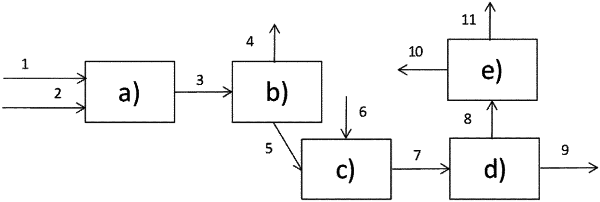| CPC C10G 67/02 (2013.01) [C10G 31/06 (2013.01); C10G 31/09 (2013.01); C10G 47/24 (2013.01); C10G 67/12 (2013.01); C10G 2300/1059 (2013.01); C10G 2300/1077 (2013.01); C10G 2300/202 (2013.01); C10G 2300/205 (2013.01); C10G 2300/206 (2013.01); C10G 2300/301 (2013.01)] | 17 Claims |

|
1. A process for the conversion of a hydrocarbon feed containing at least one hydrocarbon fraction having a sulphur content of at least 0.1% by weight, an initial boiling point of at least 340° C. and a final boiling point of at least 440° C., said process comprising the following steps:
a) a step of hydrocracking the feed in the presence of hydrogen in at least one reactor containing a supported ebullated bed catalyst;
b) a step of separating the effluent obtained from step a) into at least one light hydrocarbon fraction containing fuel bases and a heavy fraction containing compounds boiling at least 350° C.,
c) a step of precipitating sediments, consisting of bringing into contact the heavy fraction obtained from the separation step b) with a distillate cut at least 20% by weight of which has a boiling point of 100° C. or more, for a period of less than 500 minutes, at a temperature in the range of 25° C. to 350° C., a pressure of less than 20 MPa, and in the presence of an oxidizing gas wherein the oxidizing gas is ozone, and wherein part or all of the distillate cut originates from the separation step b), and
wherein the distillate cut comprises hydrocarbons containing between 13 and 40 carbon atoms,
d) a step of physical separation of the sediments from the heavy fraction obtained from the precipitation step c) to obtain a heavy fraction separated from the sediments,
e) a step of recovering a heavy fraction where the heavy fraction is a bunker fuel or a bunker fuel base having a sediment content, measured in accordance with the ISO 10307-2 method, of 0.1% by weight or less, consisting of separating the heavy fraction obtained from step d) from the distillate cut introduced during step c), and wherein the weight ratio between the distillate cut and the heavy fraction obtained from the separation step b) is in the range of 0.05 to 10.
|